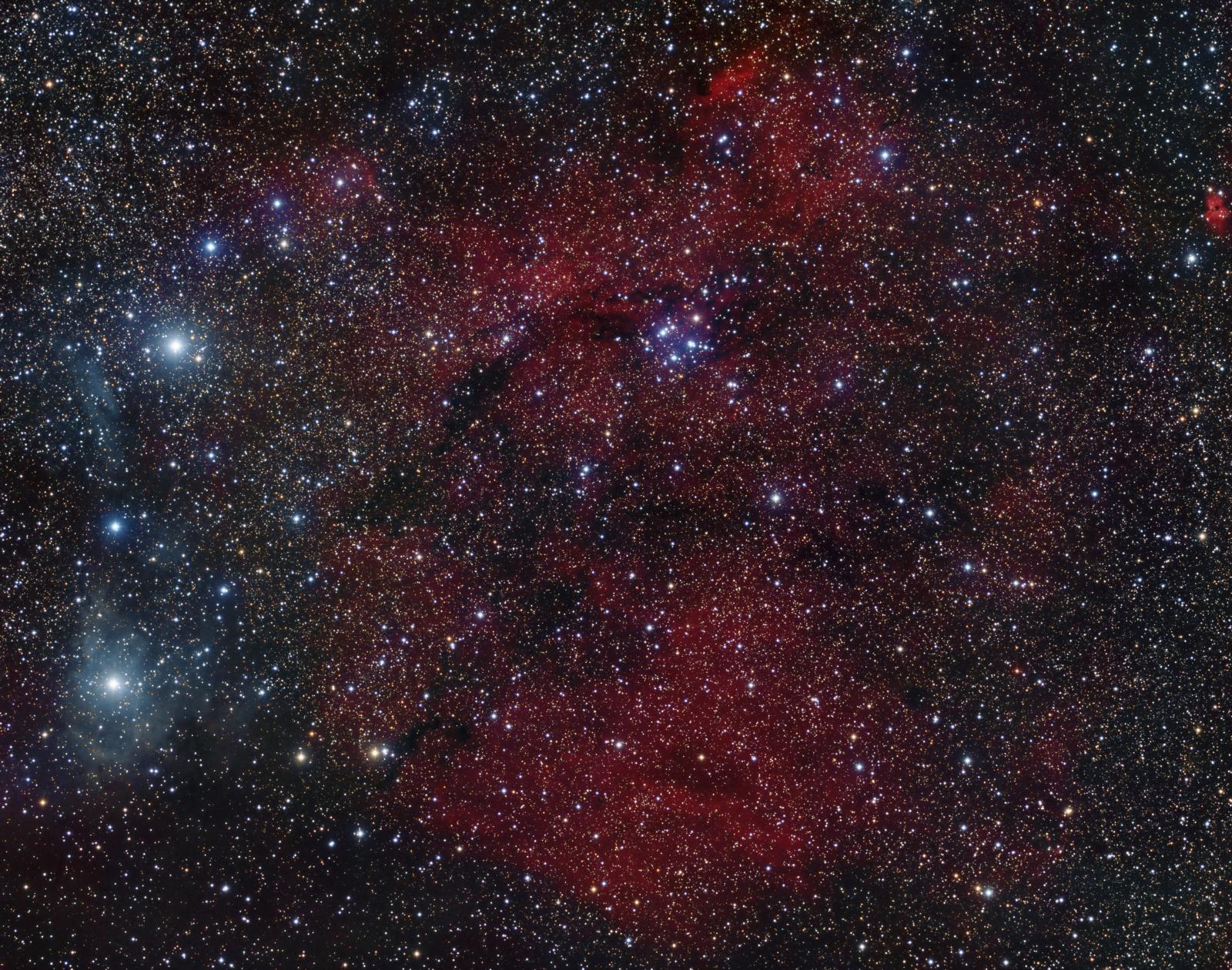Sh2-202 Region Wide Field
 Click image for full size version
Click image for full size version
January 23, 2017
Sh2-202 is the large red emission nebula occupying most of this image. It is almost 3 degrees across, or 6 times the width of the Moon, and is located in the constellation Camelopardalis (the Giraffe) on the border with Cassiopeia. It is about 2,600 light years away from us. Stock 23 is the open cluster embedded in the centre of Sh2-202, and has some hazy reflection nebula around it. On the right edge near the top of the image, the bright patch is Sh2-201. vdB 14 and vdB 15 are the two patches of reflection nebula along the left side of the image. The two bright stars lighting up these blue nebulae are variable stars, and are bright enough to be seen with the naked eye. See the annotated image for object identifiers.
Tekkies:
Moravian G3-16200 EC camera (on loan from O’Telescope), Optolong Ha, R, G and B filters, Takahashi FSQ-106 ED IV at f/3.6, Paramount MX, unguided. Acquisition with the SkyX, focused with FocusMax, scripted with CCD Commander. All pre-processing and processing in PixInsight. Acquired from my SkyShed in Guelph. Moderate moonlight for Ha, no moonlight for RGB, average transparency and seeing.
20x10m R, 19x10m G, 19x10m B and 23x10m Ha unbinned frames (total=13hr30m).
RGB:
Creation and cleanup: The BatchPreProcessing script was used to perform calibration, cosmetic correction and registration of all frames. LocalNormalization was applied, and ImageIntegration and DrizzleIntegration were used to make the Ha, R, G and B masters using Local Normalization for scaling. The masters were cropped to remove edge artifacts. R, G and B were combined to make an RGB image which was processed with DBE, BackgroundNeutralization and PhotometricColorCalibration.
Linear Noise Reduction: MultiscaleLinearTransform was used to reduce noise in the RGB image. Layer settings for threshold and strength: Layer 1: 3.0 0.8 Layer 2: 2.5, 0.7 Layer 3: 2., 0.6 Layer 4: 1.0, 0.2 Layer 5: 0.5, 0.1.
Stretching: HistogramTransformation was applied to the RGB image to make a pleasing, bright image. Curve was applied to boost contrast and saturation.
Synthetic Luminance:
Creation and cleanup of SynthL: The R, G and B0 channel masters were processed with DBE and then integrated (average, noise weighted, no rejection) using ImageIntegration to create the SynthL.
Deconvolution: A star mask was made to use as a local deringing support image. A copy of the image was stretched to use as a range mask. Deconvolution was applied (50 iterations, regularized Richardson-Lucy, external PSF made using DynamicPSF tool with about 20 stars).
Linear Noise Reduction: MultiscaleLinearTransform was used to reduce noise in the background areas of the SynthL. Layer settings for threshold and strength: Layer 1: 3.0 0.9 Layer 2: 2.0, 0.75 Layer 3: 1.0, 0.6 Layer 4: 0.5, 0.2.
Stretching: HistogramTransformation was applied to the SynthL to make a pleasing, bright image.
Noise Reduction and Re-Stretch: TGVDenoise was applied in Lab mode with 300 iterations with a range mask applied to protect high signal areas. This was followed by a HistogramTransformation to raise the black point (but with no clipping).
Combining Ha and RGB data: The NBRGBCombination script was run with default settings using Ha for red narrowband. PhotometricColorCalibration was applied.
H-alpha:
Deconvolution: A star mask was made to use as a local deringing support image. A copy of the image was stretched to use as a range mask. Deconvolution was applied (50 iterations, regularized Richardson-Lucy, external PSF made using DynamicPSF tool with about 20 stars).
Linear Noise Reduction: MultiscaleLinearTransform was used to reduce noise in the background areas of the Ha image. Layer settings for threshold and strength: Layer 1: 3.0 0.9 Layer 2: 2.0, 0.75 Layer 3: 1.0, 0.6 Layer 4: 0.5, 0.2.
Stretching: HistogramTransformation was applied to the Ha to make a pleasing, bright image.
Noise Reduction and Re-Stretch: TGVDenoise was applied in Lab mode with 300 iterations with a range mask applied to protect high signal areas. This was followed by a HistogramTransformation to raise the black point (but with no clipping).
Combining SynthL, RGB and Ha:
SynthLRGB: The processed SynthL was applied to the RGB image using LRGBCombine.
HaSynthLRGB: The NBRGBCombination script was run with default settings using Ha for red narrowband with a multiplier of 1.2. A second pass of the script using the NBRGB For broadband and assigning Ha to blue with a multiplier of 0.05. SCNR was applied to the two versions of the script output. The two versions were blended 2:1 with PixelMath.
Additional Processing:
Final Steps: MorphologicalTransformation was used in Morphological Selection mode (Selection 0.13, strength 0.6) with a star mask to slightly reduce the size of the stars. The DarkStructureEnhance script was used (8 layers, strength 0.15) to increase contrast between dark nebula and brighter regions. Background, nebula and star brightness, contrast and saturation were adjusted in several iterations using Curves with masks as required. The image was downsampled by a factor of two using IntegerResample to restore the original resolution.
Image scale is about 3.2 arcsec per pixel for this camera/telescope combination.






Thais Ron for the great image and all the all the detailed information.